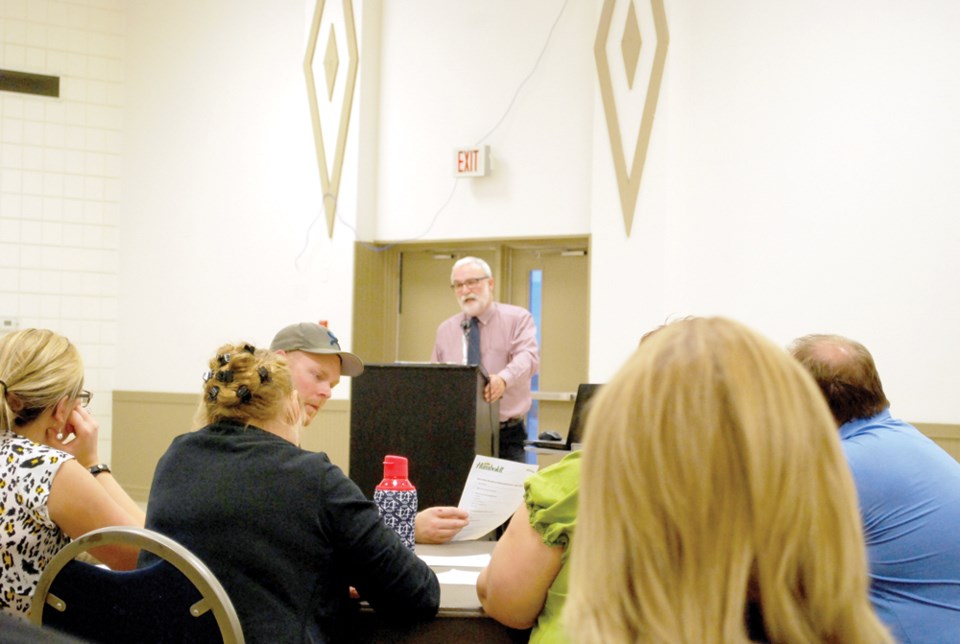Mayor Malcolm Eaton, along with city staff, addressed possible solutions to flooding issues at a public meeting on Sept. 14.
The massive rain fall of July 28 left a lot of homes with flooding and sewage backup problems.
More and more cities are having more problems with flooding from extreme weather events. The July storm dropped 122 mm. of water in a 24-hour period, the highest in Humboldt’s recorded history.
City officials and homeowners were then faced with massive flooding and sewage backup issues.
Director of public works Peter Bergquist addressed five major problems that made the current system overload that day. The top two were homeowners who still had weeping tile or incorrectly installed sump pumps.
Bergquist explained that the Humboldt water system is a two-sewer system. The storm sewer takes all the surface water from roads and sidewalks, while the sanitary sewer takes all the wastewater from homes and businesses.
Based on percentages from the day of the storm, the majority of the liquid in the sanitary sewer water came from weeping tiles and improperly installed sump pumps running directly into the sanitary sewer system.
“When we have a major rain event that saturates the ground and makes weeping tile run heavily, it puts too much of demand on a sanitary sewer system and it overloads it,” Bergquist said.
What the city is now requesting from home owners is to have sump pumps that run water out of basements and into the streets instead of weeping tile that overloads the sanitary sewer system. This way, it will then go into the storm sewer system which has a higher capacity to handle heavy water intake.
“It would add a little bit more water into the system but it is still a fraction of the amount of rain that falls that day,” Bergquist said.
The storm sewer has its own problems causing backup into city streets. But it does not contribute to sewage backup and basement flooding, unless it comes in through basement windows.
Bergquist said the city is already discussing a solution when it comes to street flooding, eventually putting in “detention ponds to hold the water until the system can catch up.”
This may still flood streets but it won’t flood homes, Bergquist said.
The city made recommendations to homeowners in 2010 after another storm that flooded homes and left sewers backed up to disconnect their weeping tile and putting in sump pumps correctly. Some homesowners say that even after following the city’s recommendations, they are still left with flooding problems.
Bergquist said that the city wants to hear about the problems. If they have everything installed properly, the problem could lie with neighbours.
“Ultimately, we want their neighbours and neighbourhoods to disconnect so it’s not causing the problem in the first place,” Bergquist said.
Residents of Stoney Lake share Humboldt’s grief when it comes to city drainage.
During July’s flood, they were issued a warning from the health region about the quality of water in Stoney. When sump pumps started pumping out basements, raw sewage was part of the mix.
Looking back into the history of Stoney Lake, cabin owner Paul Beaubien found that sewage pumped out of basements from sump pumps can end up in Stoney when the rainfall is heavy.
“The problem we have with this is they opened up the canal more and took out all the cattails, mother nature’s water filters,” he said.
Beaubien said they want to work with the city and RM and come up with a plan to contain contamination of Stoney Lake.
“We need to come up with suggestions and the town has agreed to meet with us and come up with ideas on how to handle it,” he said.
These types of drainage issues are not only a problem during massive weather events but need to be looked into more with the growth of the city.
City manager Roy Hardy said, “Having a drainage plan is going to be much more important in the future in the development of property and land around Humboldt.”
Hardy agrees that a solution needs to be put into action but this is not something that should be done without doing proper analysis.
What the discussion came down to is the fact that this is a community problem when individual homes contribute to the flooding of the neighbourhood, says Bergquist.
“Little amounts add up to a lot of water further down the pipe,” he said.




